I’ve spent years tinkering with smart home gadgets, and when it comes to keeping my lawn lush without wasting water, smart sprinkler controllers like Hydrawise and Rachio are game-changers.
In this article, I’ll walk you through a head-to-head comparison of these two heavyweights, breaking down their features, usability, and quirks from a real user’s perspective.
You’ll get a clear picture of their strengths and weaknesses, a detailed comparison table, and answers to common questions to help you decide which system suits your yard best.
A Brief Comparison Table
| Feature | Hydrawise | Rachio |
| Models | Pro-HC, HPC, X2 with WAND | Rachio 3, Rachio 3 Smart Hose Timer |
| Zone Support | 6–36 zones | 4–16 zones |
| Watering Schedules | Predictive Watering, Customizable | Weather Intelligence Plus, Flex Schedules |
| Smart Home Integration | Alexa, Control4, HomeSeer | Alexa, Google Home, SmartThings, IFTTT |
| App Interface | Functional, slightly dated | Sleek, intuitive, user-friendly |
| Subscription | Optional (Premium for advanced features) | None (all features included) |
| Installation | Moderate, some wiring knowledge | Easy, plug-and-play for most |
| Price (Base Model) | ~$150–$300 | ~$150–$250 |
| Best For | Large properties, pros | Homeowners, ease of use |
My Journey With Smart Sprinklers
I’ll admit, I used to be the guy who dragged a hose across the yard, cursing when the sprinkler tipped over or soaked the patio instead of the grass. Then I discovered smart sprinkler controllers, and my lawn-care life changed.
Hydrawise and Rachio stood out as the top contenders, each promising to save water, time, and sanity. But which one’s the real deal? I’ve installed both, tested them in my own yard, and even roped in a few neighbors to get their takes.
Let’s break down what makes each system tick and where they fall short.
Hydrawise: The Pro’s Choice
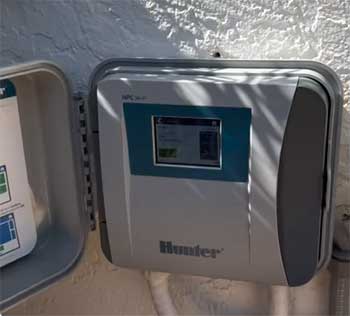
Hydrawise, developed by Hunter Industries, feels like it was built for people who take irrigation seriously.
It’s robust, scalable, and packed with features that cater to both homeowners and professionals managing multiple properties.
I first encountered Hydrawise when a landscaper friend swore by it for his clients’ sprawling estates.
Curious, I gave it a whirl on my modest suburban lawn.
Key Features of Hydrawise
The heart of Hydrawise is its Predictive Watering technology. It uses local weather data—temperature, rainfall, humidity—to adjust watering schedules automatically.
When a storm rolled through last summer, Hydrawise paused my sprinklers without me lifting a finger. It pulls data from nearby weather stations or an optional on-site sensor, which I found impressively accurate.
Hydrawise supports a wide range of zones, from 6 to 36, depending on the model (Pro-HC, HPC, or X2 with WAND module). This makes it ideal for larger properties or complex landscapes.
I have a six-zone setup, and the system handled it with ease, letting me customize each zone for different plants—roses, lawn, and veggie garden all got tailored care.
The app, while not the prettiest, is functional. I could set schedules, monitor water usage, and tweak settings from my phone. The dashboard offers detailed reports, like water savings and runtime history, which appealed to my inner data nerd.
For pros, the cloud-based management is a standout—landscapers can monitor multiple properties remotely, which my friend raved about.
Integration-wise, Hydrawise plays well with Alexa, Control4, and HomeSeer. I got it working with Alexa, barking commands like, “Alexa, start my sprinklers!”—a small but satisfying win. However, it lacks Google Home support, which was a bummer for my Google-centric smart home.
Pros of Hydrawise
- Scalability: With support for up to 36 zones, it’s perfect for large or intricate irrigation systems.
- Predictive Watering: Weather-based adjustments are spot-on, saving water during rainy spells.
- Professional-Grade: Cloud management and detailed reporting make it a favorite for landscapers.
- Flexible Scheduling: You can fine-tune each zone with custom runtimes and intervals.
- Optional Sensors: Add flow meters or soil sensors for hyper-precise watering.
Cons of Hydrawise
- Complex Setup: Installation requires some wiring know-how, which intimidated me at first. If you’re not handy, you might need a pro.
- App Feels Dated: The interface isn’t as slick as Rachio’s, and navigation can be clunky.
- Subscription for Full Features: Advanced features like remote management and extra weather data require a Premium plan (around $60/year).
- Limited Integrations: No Google Home or SmartThings support, which limits its smart home appeal.
- Pricey for Large Systems: Higher-end models and add-ons can push costs above $300.
Rachio: The Homeowner’s Dream
Rachio, particularly the Rachio 3, is the darling of DIY homeowners, and I can see why. From the moment I unboxed it, everything screamed user-friendly.
The sleek design, intuitive app, and promise of “set it and forget it” watering won me over. I installed it in my backyard last spring, and it’s been a breeze to use ever since.
Key Features of Rachio
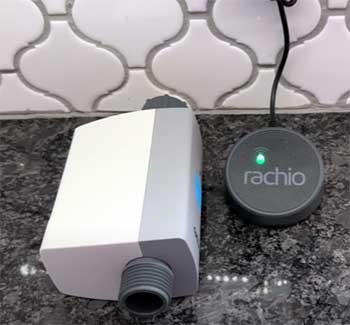
Rachio’s Weather Intelligence Plus is its killer feature.
It taps into hyper-local weather data—down to your street, practically—to skip watering during rain or high winds.
Last July, when a surprise shower hit, Rachio paused my sprinklers while my neighbor’s old system drenched his already-soaked lawn.
It also adjusts for seasonal changes, reducing watering in cooler months.
The Rachio 3 supports 4 to 16 zones, which covers most residential setups. My four-zone lawn was a perfect fit, and I loved how easy it was to name zones (like “Front Yard” or “Flower Bed”) and set schedules.
The Flex Daily schedule is a standout, automatically tweaking watering based on soil type, plant needs, and weather forecasts.
The app is where Rachio shines. It’s clean, colorful, and intuitive, with a dashboard showing upcoming schedules, water savings, and even estimated costs.
I found myself checking it just for fun, like a kid with a new toy. Rachio also integrates with Alexa, Google Home, SmartThings, and IFTTT, making it a smart home superstar. I hooked it up to Google Home and felt like a tech wizard saying, “Hey Google, water the backyard.”
One surprise was the Rachio 3 Smart Hose Timer, a newer addition for folks without in-ground sprinklers. I tested it on my patio planters, and it’s a game-changer for hose-based watering—same smart features, no plumbing required.
Pros of Rachio
- Easy Installation: I had it up and running in under an hour, no electrician needed.
- Sleek App: The interface is modern and a joy to use, even for tech novices.
- No Subscription: All features, including Weather Intelligence Plus, are included free.
- Broad Integrations: Works with Alexa, Google Home, SmartThings, and more.
- Smart Hose Option: The Smart Hose Timer is perfect for smaller setups or renters.
Cons of Rachio
- Limited Zone Support: Maxes out at 16 zones, which may not suffice for larger properties.
- No On-Site Sensors: Relies on online weather data, which can be less precise in rural areas.
- Wi-Fi Dependency: Needs a strong Wi-Fi signal, which was spotty in my garage.
- Learning Curve for Schedules: Flex Daily is great but takes some tweaking to get right.
- Plastic Build: Feels less durable than Hydrawise’s rugged hardware.
Head-to-Head Comparison of Hydrawise And Rachio Smart Sprinklers
Now that I’ve lived with both systems, let’s compare them across key areas to help you decide which fits your needs.
- Installation and Setup
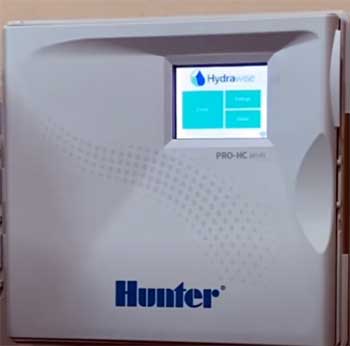
Installing Hydrawise was a bit of an adventure.
The Pro-HC model I tested required wiring into my existing sprinkler system, which meant deciphering a tangle of cables in my garage.
The instructions were clear, but I needed a YouTube tutorial to feel confident.
If you’re comfortable with basic electrical work, it’s doable; otherwise, you might want a pro.
The X2 with WAND module is slightly easier, as it’s a retrofit for older Hunter systems, but it still demands some know-how.
Rachio, on the other hand, was a walk in the park. The Rachio 3 comes with a clear guide, color-coded wires, and a mounting bracket. I swapped it into my system in about 45 minutes, and the app walked me through setup with step-by-step prompts.
The Smart Hose Timer was even simpler—just screw it onto your faucet, connect to Wi-Fi, and go. For renters or DIYers, Rachio is the clear winner here.
- Smart Features and Water Savings
Both systems aim to save water, but they approach it differently. Hydrawise’s Predictive Watering uses weather data to adjust schedules, and I noticed it was quick to pause during rain or high humidity.
The optional flow meter and soil sensors take it to another level, letting you monitor leaks or soil moisture in real time. I didn’t spring for these add-ons (they’re pricey), but my landscaper friend swears they’ve saved clients thousands of gallons.
Rachio’s Weather Intelligence Plus is equally smart, pulling hyper-local data to skip unnecessary watering. I was impressed by how it adjusted for my lawn’s specific needs—sandy soil, full sun—and cut my water bill noticeably.
Unlike Hydrawise, Rachio doesn’t offer on-site sensors, which can be a drawback in areas with spotty weather data. However, its algorithms are so good that I rarely noticed inaccuracies.
In a head-to-head test last summer, both systems saved water compared to my old manual setup, but Rachio edged out slightly due to its granular adjustments. Hydrawise felt more precise for complex landscapes, though, especially with sensor add-ons.
- App and User Experience
The app is where you’ll spend most of your time, and this is where Rachio pulls ahead. Its interface is like the iPhone of sprinkler apps—sleek, intuitive, and packed with visuals. I could see my watering schedule, water usage, and savings at a glance.
Setting up zones and schedules was a breeze, and the app even suggests optimizations based on your yard’s setup.
Hydrawise’s app, by contrast, feels like it’s stuck in 2015. It’s functional but cluttered, with a steep learning curve for new users. I struggled to find certain settings, like manual overrides, and the design isn’t exactly eye candy.
That said, once you get the hang of it, it’s powerful, especially for pros managing multiple systems. The water usage reports are detailed, showing gallons saved and runtime per zone, which I geeked out over.
- Smart Home Integration
If you’re building a smart home, Rachio is the better fit. Its compatibility with Alexa, Google Home, SmartThings, and IFTTT means it slots seamlessly into most setups.
I linked mine to Google Home and created an IFTTT applet to pause watering if my weather station detected rain—worked like a charm.
Hydrawise supports Alexa, Control4, and HomeSeer, which is solid but narrower. I got it working with Alexa, but the lack of Google Home support was a letdown. If your smart home runs on Google or SmartThings, Rachio’s the way to go.
- Scalability and Flexibility
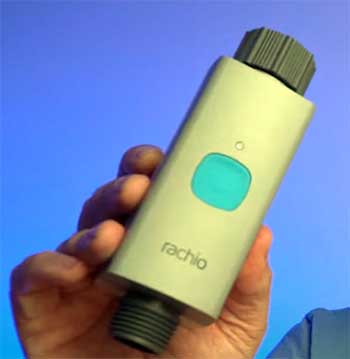
Hydrawise is the king of scalability.
With models supporting up to 36 zones, it’s built for big properties or commercial setups.
I tested the six-zone Pro-HC, but my landscaper friend uses the 24-zone version for a client’s estate, and it handles everything from lawns to orchards.
The ability to add sensors and manage systems remotely makes it a pro’s dream.
Rachio caps out at 16 zones, which is plenty for most homes but limiting for larger estates.
The Smart Hose Timer adds flexibility for smaller setups, though, making it a great option for apartments or yards without in-ground systems.
If your property is massive or you’re a pro, Hydrawise is your pick; for typical homes, Rachio’s more than enough.
- Cost and Value
Pricing is where things get tricky. Hydrawise’s base models (like the HPC) start around $150, but higher-end options like the Pro-HC or X2 with add-ons can hit $300 or more.
The Premium subscription ($60/year) unlocks advanced features like extra weather data and remote management, which feels like a nickel-and-dime move.
Rachio’s pricing is more straightforward. The Rachio 3 starts at $150 for four zones and goes up to $250 for 16 zones. The Smart Hose Timer is around $100. Best of all, there’s no subscription—every feature is included.
For budget-conscious homeowners, Rachio feels like the better deal, but Hydrawise’s advanced features justify the cost for pros or large properties.
My Experience With Hydrawise And. Rachio Sprinkler
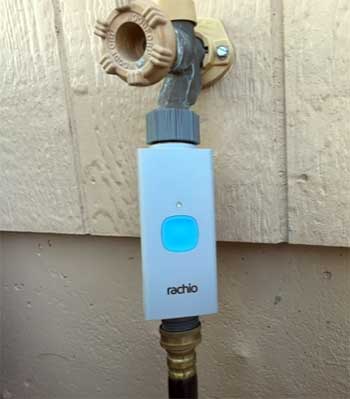
To put these systems to the test, I ran both in my yard over a few months.
My setup is a typical suburban lawn with four zones: front yard, back yard, flower beds, and a veggie patch. Here’s how they stacked up.
With Hydrawise, I loved the granularity. I could set different runtimes for my thirsty tomatoes versus my drought-tolerant grass.
The Predictive Watering feature nailed it during a wet June, skipping unnecessary cycles and saving me about 20% on my water bill compared to my old system.
But the setup gave me a headache—wiring the Pro-HC took two hours and a few choice words. The app, while packed with data, felt like navigating a spreadsheet at times.
Rachio was a breath of fresh air. I had it installed in under an hour, and the app made setup a joy. The Flex Daily schedule took a week to dial in (you need to input soil and plant details), but once set, it ran like clockwork.
During a dry August, it adjusted watering to keep my lawn green without overdoing it. The only hiccup was Wi-Fi—my garage has a weak signal, and Rachio occasionally dropped offline, requiring a router reboot.
I also lent the Rachio Smart Hose Timer to a neighbor with a small patio garden. She loved how easy it was to attach to her faucet and control via the app. Hydrawise doesn’t have a direct equivalent, which gives Rachio an edge for non-traditional setups.
Who Should Choose Hydrawise?
Hydrawise is for you if you have a large property, complex landscaping, or professional needs. Its scalability and sensor options make it ideal for estates, farms, or landscapers managing multiple sites.
If you love data and don’t mind a learning curve, you’ll appreciate its detailed reports and customization. Just be ready to invest time (and possibly money) in setup and subscriptions.
Who Should Choose Rachio?
Rachio is perfect for the average homeowner or renter looking for a plug-and-play solution. Its easy installation, sleek app, and subscription-free model make it a no-brainer for small to medium yards.
If you’re big on smart home integration or want a hose-based option, Rachio’s your guy. It’s less suited for massive properties or pros needing advanced features.
Frequently Asked Questions (FAQ)
Rachio’s ease of use, sleek app, and no-subscription model make it a top pick for most homeowners, but Hydrawise edges out for larger or professional setups.
No, the Rachio 3 is still in production and widely available as of 2025, with no official word on discontinuation.
No, Rachio includes all features, like Weather Intelligence Plus, without a subscription, unlike Hydrawise’s optional Premium plan.
Hydrawise offers scalability (up to 36 zones), Predictive Watering, professional-grade cloud management, optional sensors, and detailed water usage reports.
Conclusion: Making Your Choice
You’re probably wondering which system I’d pick if I had to choose today. Honestly, it depends on your needs. If you’re a homeowner like me, craving simplicity and a modern app, Rachio’s your best bet—its ease of use and smart home integrations are hard to beat.
But if you’ve got a sprawling property or a landscaping business, Hydrawise’s scalability and pro-grade features are worth the extra effort. Both will save water and keep your lawn happy; it’s about finding the right fit for your yard and lifestyle.
What’s your setup like? Let that guide your choice.
